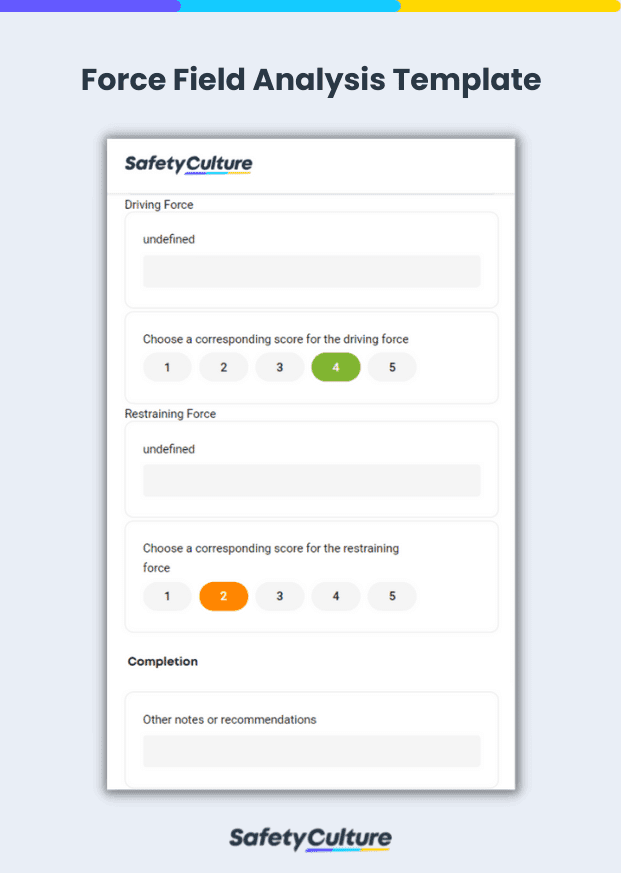What is a Force Field Analysis Template?
A force field analysis template is used to help teams in listing forces that are for and against a proposed change or solution, analyzing such forces via a scoring system before considering for implementation, and providing recommendations for the next steps to take based on the results of the analysis.
As a powerful decision-making tool, this template provides a more straightforward and cohesive presentation of the different forces that revolve around managing changes or solutions to improve or amend operations and other business processes.
Why Should You Use One?
Kurt Lewin, a German-American social psychologist, developed the principle of force field analysis and it aims to help organizations determine how various factors influence proposed changes in business processes. In any problem solving and decision making, weighing the pros and cons before implementation is a must to avoid incurring unnecessary business costs and encourage proactive solutions instead. Utilizing straightforward tools and methods like a force field analysis template won’t just let you simplify the way you make decisions, but also promote a heuristic approach and healthy culture of collaboration toward quality organizational change.
Using a force field analysis template is helpful in:
- ensuring all the steps involved in the overall force field analysis process are covered;
- solidifying the foundations for the desired change or shared vision by having all the driving and restraining forces recorded in one template that can be exported as a data-rich report;
- quantifying the two sides of the evaluation process to efficiently weigh the driving and restraining forces using their individual total scores;
- coming up with more accurate recommendations for the proposed change or solution before implementing it; and
- enhancing stakeholders’ and an organization’s decision-making skills
With these impactful capabilities, a force field analysis template that’s created to suit the needs of the organization will boost the effectiveness of a discussion or analysis. Thus, it’s crucial to understand what it should include to avoid missing out on key details.
What Does a Force Field Analysis Template Include?
This is also where the question “How do you write a force field analysis template?” come in. To further guide you in creating one, here are some key sections your template must include.
Title Page
This is where essential details about the force field analysis that your team has conducted are included. Such information include the name of the proposed change or solution, the Person-in-Charge (PIC), the date when the analysis was held, and the location of the meeting.
Having all these recorded in the template will come in handy when you’re ready to export the analysis inspection report in PDF or Word format.
Driving Forces with a Scoring System
During the analysis proper, teams must allot this section to outline the reasons behind or factors that positively drive the proposed change or solution. In short, the driving forces are considered in favor of the implementation.
It’s best to list as many driving factors as possible in order to contribute to an objective and proactive weighing of decision after the analysis. Finalize this section by ensuring that all of the driving forces are tallied with a score.
Restraining Forces with a Scoring System
Pertaining to the factors that oppose the implementation of the proposed change, the list of restraining forces should also have a separate section in the force field analysis template.
Same with the driving forces section, use this part to list all possible restraining forces that would further help strengthen the decision-making process. Assign a corresponding score for each restraining force as well.
Completion
Finally, this section houses all supplementary notes and recommendations to conclude the analysis. Specify the decisive factors that help you arrived at this conclusion. Such details aim to summarize the results and the decided course of action.
For example, if the driving forces need to be strengthened to counteract the restraining forces, the specific steps to do this must be outlined for another round of analysis or discussion. On the other hand, postponement of the implementation can be considered if the restraining forces are found to be more compelling and it would be irrational or not ideal to push through with the proposed change. Another option for this situation may be to identify other ways to implement the proposed change or solution.
Further, you may customize the force field analysis template by including an option for sign-offs to put the PIC’s name and signature at the bottom.



